- About
- Topics
- Picks
- Audio
- Story
- In-Depth
- Opinion
- News
- Donate
-
Signup for our newsletterOur Editors' Best Picks.Send
Read, Debate: Engage.
| topic: | Natural disaster |
|---|---|
| located: | Thailand |
| editor: | Hanan Zaffar |
As climate change continues to cause natural disasters, Bangkok has grappled with recurring floods that have harmed vital infrastructure and affected thousands of residents. Due to its faulty urban planning, Thailand’s capital city - home to more than 11 million people - is highly susceptible to flooding, especially affecting poorer neighbourhoods. A 2015 report by Thailand's National Reform Council warns that unless immediate action is taken, Bangkok might be submerged in less than 15 years.
Bangkok is built on a delta, where several rivers converge before flowing into the Gulf of Thailand. The city has experienced rapid urbanisation, including the pavement of the once-swampy grounds with concrete, the construction of high-rises and the mass-extraction of groundwater from beneath the city’s surface for human and industrial use. While these changes have helped modernise the city, they have also caused the city to sink by about two centimetres per year.
A large portion of Bangkok’s population lives in poverty in the city’s slums, where unstable houses are at the mercy of floods. When the water levels rise, the inhabitants either abandon their places or move to higher grounds and return back to the flood-affected houses once the water recedes.
The dense layer of concrete which has been built to urbanise the city and improve its infrastructure has made the effects of flooding even worse. Since the city is covered with roads, canals, tunnels and sewer pipelines, floodwater - which should normally wash away into wetlands or seep into the ground to refill aquifers - has no way to go. The result is reduced groundwater and rushing floods over the city.
Like elsewhere, most of the poor in the Southeast Asian country turn towards the capital city in hope of better opportunities. But they end up living in highly underdeveloped spaces due to the high cost of better accommodations. These neighbourhoods are not built with the inevitable flooding in mind and are therefore not equipped to protect the inhabitants from rising waters. As the heavy rain patterns caused by climate change continue to overflow the rivers, the country’s poor population with weak walls suffers the most.
The government has taken steps to relocate slum dwellers to safer areas as a response to the recurring floods in Bangkok. In one instance, an illegal settlement was demolished, and the residents were resettled to a better-planned location away from the canals that overflowed during floods.
However, there are still many who have yet to be relocated, and experts warn that time is running out for the authorities to address the issue. The high cost of resettlement and concerns among the poor about moving are the primary obstacles to progress.
Image by Evan Krause

